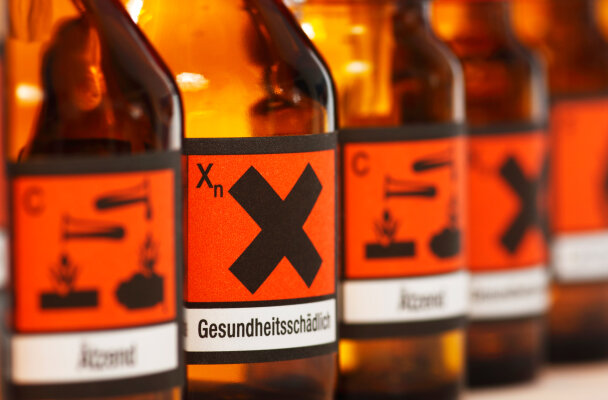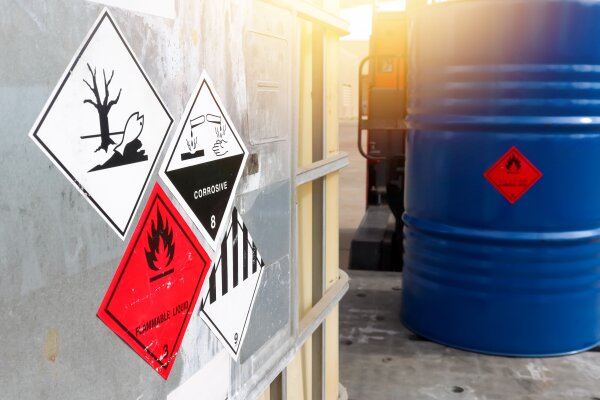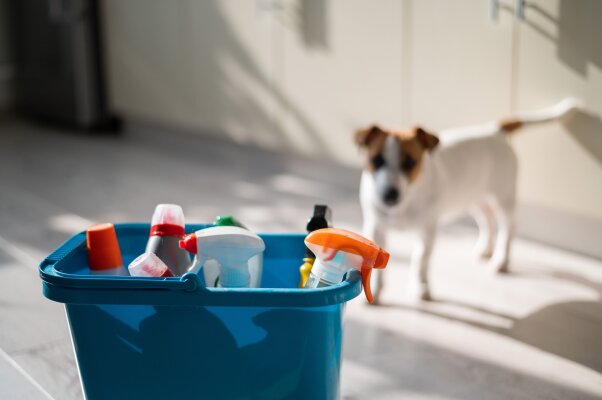Dangerous goods class 3: flammable liquid substances

In order to make the handling of hazardous materials safer in everyday life as well as in road traffic, corresponding materials have been divided into different hazardous materials classes. These are structured according to hazard characteristics and divided into nine ADR classes. We have summarized for you in this blog post which substances are included in dangerous goods class 3, what to look out for in terms of labeling and packaging, and which legal requirements apply.
Dangerous goods class 3: Definition
If we are talking about dangerous goods class 3, then we are talking about flammable substances that are liquid at a given high or low vapor pressure and do not exceed a flash point of 60 °C. In addition, they must not exceed a pressure of 1,013 mbar at a temperature of 20 °C and a pressure of 3 bar at a temperature of 50 °C. Common examples of substances in this class includegasoline and alcohol.
Flash point
One of the most important classification criteria is the flash point already mentioned. This indicates thelowest temperature at which a flammable, liquid hazardous substance can still ignite. This is mainly due to the vapor-air mixture, which in the case of liquid substances is volatile – and not infrequently highly flammable. The flash point is mostly specified at a pressure of 1,013 mbar and must not exceed the limit of 60 °C for substances of dangerous goods class 3.
High steam pressure
In addition, dangerous goods of this ADR class are classified with regard to their vapor pressure. A distinction can be made here between a high and a low vapor pressure. High vapor pressure is spoken of when high outside temperatures prevail and these also increase the vapor pressure of the hazardous substance. An evaporation process occurs, so that the substance behaves in a volatile mannerand the risk of fire increases.
Low steam pressure
equivalent, the low vapor pressure is determined. If the outside temperature drops, so does the vapor pressure of hazardous material class 3 substances. The natural evaporation process is slowed down, which is why the gas can spread less quickly.
Other properties of flammable liquids
In addition, there are other properties that flammable liquids can bring with them, which must not be forgotten when considering the hazards of this ADR class. These include, for example, the fact that the substances form a highly flammable air-gas mixture that can lead to an explosion in combination with fire, especially in enclosed spaces. Some of the substances are also toxic and/or corrosive, which is differentiated in the individual classification codes of the dangerous goods class.
Classification codes of ADR dangerous goods class 3
Bei Gefahrgut ist es außerdem elementar, dass die Klassifizierungscodes sowohl angegeben als auch beim Transport deutlich sichtbar sein müssen. This labeling serves to make the hazards of the substance clearly visible – for example, “T” stands for toxic or “F” for flammable. Class 3 dangerous goods are divided into the following classification codes:
| Classification code | Dangerous property |
| D | Desensitized explosive liquids |
| FC | Flammable liquid substances, corrosive |
| F | Flammable liquid substances without subsidiary risk |
| F1 | Flammable liquids with a flash point not exceeding 60 °C |
| F2 | Flammable liquids having a flash point above 60 °C which are loaded or carried for carriage heated to or above their flash point. |
| F3 | Articles containing flammable liquid substances |
| F4 | Substances with a flash point above 60 °C which are heated in a boundary range of 15 K below the flash point and which are loaded or carried for carriage |
| F5 | Substances with an ignition temperature of less than 200 °C |
| FT1 | Flammable liquid substances, toxic |
| FT2 | Flammable liquid substances, toxic - application in pest control |
Packing groups of dangerous goods class 3
However, not only the classification codes, but also the packaging groups must be specified when it comes to the declaration and transport of dangerous goods class 3. Here, three groups are differentiated as follows:
- VG I:Substances in this packing group present a high hazard. In addition, their initial boiling point is below 35 °C, which may make further precautions necessary
- VG II: These substances are goods with medium danger. Their flash point is lower than 23 °C, but the onset of boiling is already above 35 °C
- VG III:Finally, there is the third packing group, which is defined by a low hazard of the substances. The flash point of the goods is in each case between 23 °C and 60 °C with an initial boiling point above 35 °C
In addition, packaging groups must be coded, which defines certain requirements for the packaging per se. A distinction can be made between X-coding, Y-coding and Z-coding.
Legal regulations regarding class 3 dangerous goods
When dealing with Class 3 hazardous substances, there are several legal regulations, compliance with which is mandatory. These refer to the requirements for the employer as well as to protection regulations and storage. In particular, the following regulations should definitely be taken into account:
- Hazardous substances law (general hazardous substances law,chemical laws and special hazardous substances law (such as plant protection law and food law))
- Ordinance on Hazardous Substances
- European Hazardous Substances Directives
- Dangerous Goods Ordinance for Road and Rail (GGVSEB)
Protective measures against hazardous substances
When handling hazardous materials of all kinds - i.e., also those in Hazardous Materials Class 3 - a number of protective measures also apply, compliance with which helps to limit the risk. In particular, the Technical Rule TRSG 500 indicates approximately how the hazard assessment should turn out and which protective measures are to be taken. These include, for example:
- Suitable design of the workplace, work organization and work equipment including maintenance
- Limitation of the number of exposed persons as well as the duration and level of exposure
- Limitation of hazardous substances in the workplace to the required amount
- In-house labeling and an implementation of appropriate procedures and methods for storage and disposal.
- Carrying out the risk assessment again and taking suitable, further protective measures.
Storage of substances of dangerous goods class 3
Dangerous goods class 3 substances belong to flammable liquids, which is a shared property with classes 6.1 to 8. Therefore, care must also be taken here during storage to ensure that no actual hazard can arise. In addition to the labeling according to the applicable labeling ordinance BGBl II No. 101/1997, for example, the following factors must also be adapted to the dangerous goods:
- Possible storage prohibitionsthat apply, for example, in exits, passages and locks
- Matching shelves and stacks that do not exceed the maximum permissible load capacity
- Suitable packaging including markingof the corresponding packaging group
- Implementation of shatterproof containers
- A sufficiently high or sufficiently low storage temperature
Dangerous goods class 3: The mandatory marking
According to the Dangerous Goods Ordinance for Road and Rail (GGVSEB), special labels must also be used for dangerous goods, each of which applies to specific substances. For this purpose, there are both dangerous goods labels and dangerous goods labels that must be visibly attached when transporting dangerous goods.
The hazard labels include a specific color, shape and a hazard symbol according to GHS, which must be shown on the upper half. These symbols are also standardized and look as follows:
| Pictogram | Coding | Signal word | Examples |
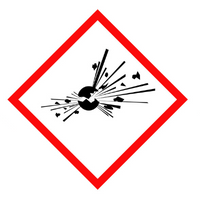 |
GHS01 - Explosive substances | Danger | unstable explosive substances,spontaneously combustible substances |
 |
GHS02 - Flammable substances and mixtures | Caution or danger | flammable, pyrophoric, self-heating gases |
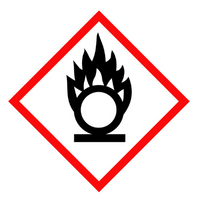 |
GHS03 - Flammable and oxidizing substances and mixtures | Danger | Inflammatory (oxidizing) action |
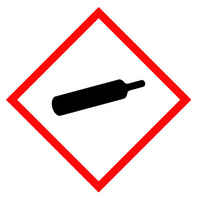 |
GHS04 - Pressurized gases | Caution | Gases under pressure, compressed, liquefied, dissolved gases |
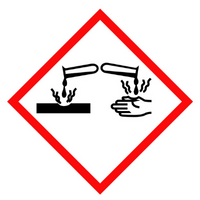 |
GHS05 - Substances which are corrosive to skin, harmful to eyes and harmful to metals. | Caution or danger | Metal corrosive substances |
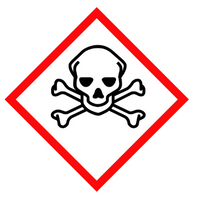 |
GHS06 - Acutely toxic substances | Caution or danger | Acute toxicity |
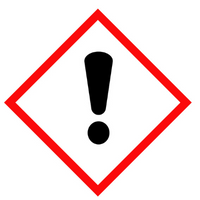 |
GHS07 - Health hazard | Caution | skin irritant, eye irritant |
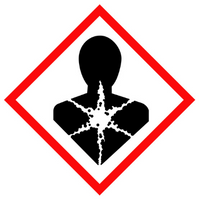 |
GHS08 - Systemic health hazards | Caution or danger | various health hazards, e.g. harmful to skin, lungs and eyes |
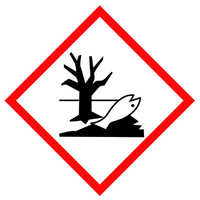 |
GHS09 - Environmentally hazardous to the aquatic environment | Caution or without signal word | hazardous to the environment and water |
Dangerous goods labels
In addition, hazardous material labels still come into play, which in turn can be divided into three categories: Orange hazard labels for explosive substances, white labels for toxic and infectious substances, and yellow labels for flammable substances. Dangerous goods labels must also be used for identification during transport.
Danger label for transport of dangerous goods
The hazard label for the transport of dangerous goods class 3 has the GHS symbol of the flame on the upper half, while the number 3is noted on the lower half. If applicable, the letter of the compatibility class is also noted there. Such a danger label can be easily purchased online as a sticker.
Measures in the event of damage
However, if damage does occur, action should be taken as quickly as possible. As substances of dangerous goods class 3 are flammable liquid substances, the following immediate measures are appropriate:
- Removal of all possible ignition sources in the vicinity
- Preventing penetration into the sewer system and/or deeper rooms with the help of a suitable cover
- Avoid inhalationof any vapors
- Fighting small fires with a fire extinguisher
- Removal and disposalof contaminated clothing
- Notification of the rescue service in case of direct ingestion
Dangerous goods class 3: correct handling
Correct handling is mandatory so that no actual hazards emanate from goods in dangerous goods class 3. In addition to appropriate labelingand storage, this also includes complying with all legal requirements and taking immediate action in the event of damage.
FAQ‘s
Dangerous goods class 3 combines flammable and liquid hazardous substances, which allows storage and transport to be standardized. It belongsto the ADR classes, which range from 1 to 9.
Typical examples of substances in this class include gasoline and alcohol. But also some liquid metals can be counted to ADR class 3.
Three different packaging groups are possible for dangerous goods class 3, which refer to the emanating danger of the substance and to theboiling and flash point. Substances for packing group 3 (VG III) present only a slight hazard.

